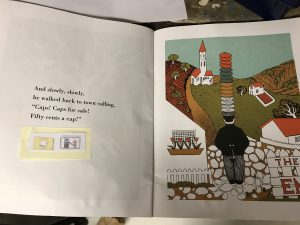
Joey gave me one of his huge, award-winning smiles when he saw me pull out my Caps for Sale book kit for the first time. It was clearly a book he was familiar with. I love this book, and I’d been waiting for the right moment to use it with Joey.
Most of the work I do with Joey is centered around a core-text. I carefully choose a book that will let me intertwine Joey’s goals into activities related to the story. Caps for Sale is rich with opportunities for interaction, so I was as excited as Joey was to finally read it with him.
For those of you not familiar with Caps for Sale, it’s about a peddler who sells caps. He carries his caps on his head (sorted by color). One day, when no one wants to buy any caps, he takes a nap against a tree. When he wakes up, his caps are gone. He looks everywhere and finally sees the caps up in the tree, on the heads of monkeys. As he yells to the monkeys to give him back his hats, the monkeys copy everything he does – waving their firsts, and stomping their feet, and saying “tsk, tsk, tsk” while he yells “Give me back my caps!”. Finally, the peddler gets so angry that he throws his own hat onto the ground. And the monkeys, who have already been copying all of the peddler’s movements, throw their hats onto the ground as well.

This book is a great one to use as a core text for lessons, and for what we call an “interactive read aloud.” An interactive read aloud is when we create opportunities for children to interact with a book before, during, and after the story. We may ask questions before we read to see what the children think will happen in the book, ask questions during the story, ask children to read along with us, talk about how we can relate to the story ourselves, or act out the story afterward (DeBruin-Parecki, 2009).
A 2016 study by Loes van Druten-Frietman, Heleen Strating, Eddie Denessen, and Ludo Verhoeven listed three main components of what makes an effective read aloud:.
- The story should be read several times, with the children being encouraged to participate.
- The teacher asks and responds to questions, models language from the book, and provides feedback to the children using the language from the book.
- The teacher also helps children relate the book to personal experiences (Druten-Frietman, et al, 2016).
Caps for Sale is perfect for this, because it offers so many opportunities to encourage children to participate in the read aloud. The children can copy the peddler’s call when he asks if anyone wants to buy a cap (“Caps! Caps for sale! Fifty cents a cap!”)* When the peddler is looking for his hats, children can copy his actions – look to the right of him, the left of him, behind him, and finally above him. Children can copy the peddler’s movements as he shakes his finger, fists, and stomps his feet at those monkeys.
Caps for Sale is also a great book for working on directional words. When we are working with children with developmental delays, we often need to deliberately and explicitly teach this language. Caps for Sale gives us an opportunity to teach these words in a meaningful way. We can draw the children’s attention to when the peddler looks for his hats, behind the tree, below him, to the right and to the left of him.
It is important to keep in mind that just reading the book itself is not enough to help children learn and use the vocabulary words (Justice, et al, 2005). Instead, we need to be deliberate in how we draw children’s attention to these specific words. We can have the children act out the words, and then draw attention to these words in different contexts. With Caps for Sale, practice using these directional words outside the book. You can play hide and seek with a hat and use the words “above” and “below” to tell your child where you hid it. Throughout the day, you can use the words to talk about where things are in your house.
I also like using Caps for Sale to work on expressive language skills. Because of the book’s repeated story lines, after multiple readings children learn the lines or at least when words from the story will be said. By pausing before these repeated lines, or during them, you can encourage children to join you in reading, even if they are using a communication device. In doing so, be sure to give an appropriate pause so that children know they are expected to provide a response (Bellon, et al, 2000; Comar, 2011, 2014). This pause should be for two seconds or more.
The story is also a great one to act out, and a classroom of children (or even siblings) can stand face to face, with one child being the peddler and others being the monkeys, copying the peddler’s every move. This activity ties into the book and reinforces the meaning of the story, while also encouraging children to work on their joint attention and motor planning skills. In order to complete this activity they need to watch someone else and then plan their movements based on that person. While it can be a fun, silly game, it also provides good practice for attending to others.
Caps for Sale also gives us a chance to work on academic skills, like counting or sorting items by colors. The peddler sorts his hats by color, so you can create activities where your children are sorting different items by color, just like the peddler. If your child is not ready to sort items, he or she can work on just identifying items by color, and looking for all the red toys, then the blue toys, then the brown toys (just like the hats in the book). Count the monkeys in the story with your child, and count the hats.
Joey and I read, and re-read (and continued to re-read) Caps for Sale. I love watching him get so many different experiences out of one book. As always, I love when he uses his AAC device to trick me. Just like when we read Pete the Cat, Joey thinks it is hysterical to tell me the wrong colors of the peddler’s caps, and then say “YES” when I say “No”. Nothing like watching his three-year-old personality shine through with some literacy-based humor.
*Since Joey did not have any of those words on his AAC device, I added the sentence “Do you want a hat?” so that Joey could say the words “you want” along with the reader.


